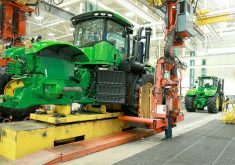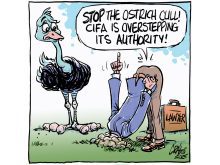Keep promise?
Saskatchewan Wheat Pool is experiencing very severe financial problems. Agricore United, the other one-time farmer owned and controlled grain handling co-operative, isn’t in much better financial shape.
The deregulation of the railroads (and) removal of the Crow Rate are the main reasons for these grain companies’ financial hardships. The removal of the freight rate cap and legalization of variable freight rates allotted to the railroads the power and ability to charge a higher freight rate for the elevators that they did not want to serve any elevator smaller than a 50-car loader.
Read Also

Trump’s trade policies take their toll on Canadian producers
U.S. trade policy as dictated by president Donald Trump is hurting Canadian farmers in a multitude of ways.
Elevators, or shall we say inland terminals, with ability to load at one sitting 50 or 100 grain cars are given freight rate breaks of $4 and $6 a tonne respectively.
The railroads now have the power to shape the grain handling system just the way they want it, regardless of the financial hardships imposed on grain companies and grain producers.
With a stroke of the federal government’s pen, the conventional crib elevator system was turned into a liability, just so much waste material that had to be disposed of at a great cost, forcing Sask Pool and the other once farmers co-operatives to borrow a huge amount of capital to build inland terminals, putting themselves into an extremely vulnerable financial position. It is doubtful that either company will survive intact without financial assistance.
The federal government promised that if any financial hurt happens because of the removal of the Crow Rate agreement, they would compensate those effected.
Will the federal government keep this promise? It is my opinion that they are fully obligated to do so.
– George Hickie,
Waldron, Sask.
Pig toys
Your article “U.K. farms turn pigpens into playpens,” while undeniably amusing, is alas merely the product of someone’s over-active imagination.
The European Union did indeed adopt in November 2001 a directive on animal welfare, which laid down minimum standards for the management and protection of pigs in the EU, including their treatment and accommodation. However, there is no mention of toys, nor of penalties for not providing toys.
The directive states that “pigs must have permanent access to a sufficient quantity of material to enable proper investigation and manipulation activities, such as straw, hay, wood, sawdust, mushroom compost, peat or a mixture of such, which does not compromise the health of the animals.”
Before anyone now accuses the EU of depriving pigs of their fun, let me stress that, should any farmer nevertheless feel an irresistible urge to provide his pigs with footballs, basketballs or similar playthings, nobody in the EU bureaucracy is going to stand in his way.
– Eric Hayes,
Ambassador, European
Commission to Canada,
Ottawa, Ont.
Use data
Michelle Kraft is using the tactics of the Saskatchewan Party in that she criticizes the NDP without using any data to support her negative statements (Open Forum, Jan. 2.)
Perhaps it was (Elwin) Hermanson, leader of the Saskatchewan Party, whom she was emulating because he recently was in Alberta speaking at fundraising meetings. Here are some data she could think about.
1. In Saskatchewan we receive our annual Medicare cards free of charge. In Alberta a family pays $1,056 each year for their card.
2. Our Saskatchewan Government Insurance motor licence renewals, which include a broad range of medical and physical benefits in the event of an accident, are the lowest or among the lowest of anywhere in Canada. To license and insure a 2001 Ford Taurus SE four-door sedan and its owner in the year 2001 cost $2,330 in Calgary but only $1,183 in Saskatchewan. …
Also, do youth under the age of 25 still have to pay a hefty surcharge to insure a vehicle and drive in Alberta? We have never had this in Saskatchewan.
3. Our natural gas residential rates are the lowest of 12 major cities in North America (Source: Vancouver Province, June 2001.) Sask Energy average annual total, $946.50 per year; Atco gas, Calgary $1,803; Atco Gas Calgary with its requested 70 percent increase, $3,065.10, all figures based on a typical annual household consumption of 150 gigajoules.
Don’t forget that after (Alberta premier Ralph) Klein privatized provincial gas supplies, he had to reimburse users for the exorbitant markups and profit taking imposed by the new natural gas suppliers. If he hadn’t been so foolish as to privatize, that money could have been used to subsidize Medicare, education or some other public requirements.
– F. J.H. Fredeen,
Saskatoon, Sask.
Causes of death
The top four causes of death in Canada are heart and circulatory disease, approximately 36 percent; cancer, approximately 28 percent; respiratory system diseases, approximately 10 percent; and digestive system diseases, approximately 3.6 percent.
These statistics are from Statistics Canada. These causes of death have taken the lives of approximately 1,193,598 Canadians in the last seven years, the time span of this latest gun control charade.
The Canadian Medical Association says that with sufficient funding (say a billion dollars over the last seven years) more than half of these deaths are preventable.
The true cost of gun control is approximately 596,799 lives lost, approximately 42 percent of this number being women.
Back in 1987 the then-justice minister (Kim Campbell) said “there is in Canada today, over 7.9 million gun owners and over 27 million guns.”
For any law to work it must have the overwhelming support of those affected by such same law. Clearly this is not the case, as perhaps as many as five million gun owners are not in compliance.
The real cost in innocent lives of seven years of gross overspending and theft of public funds, more lives lost than during the Second World War.
If this is the Liberal way to improve life in Canada, we cannot afford more.
– Walter Gripping,
Granum, Alta.
Wasteful drive
The picture in the Dec. 19 Western Producer showing the cattle drive using four four-wheel drive tractors is the most ridiculous, absurd and wasteful I have ever seen. I would rather the story ended with giving sponsorships to hundreds of World Vision children that same amount of money instead of wasted by this type of trail drive.
My experience with cattle drives started at age 16 with three cowboys and a chuck wagon moving the herd 35 miles in five days from home base to summer range.
– Dewey Cummins,
South Hazelton, B.C.
Step backward
If Art Macklin’s viewpoints expressed in a recent Western Producer letter are any indication of the vision of the Canadian Wheat Board, then that vision appears to be moving toward the Stone Age as opposed to the 21st century.
His statement that many communities have been abandoned by grain companies ignores the fact that a grain handling infrastructure based on tiny, uneconomical elevators dotting the prairie landscape has not had a viable future for many years.
Having to maintain this system at the behest of the likes of Mr. Macklin has cost grain handling co-ops, and the farmers that owned them, dearly. We are only now beginning to see the consequences of policies that favoured high-cost, next-door service over a streamlined, market-driven approach.
But rather than learn from these mistakes and look to the future, Mr. Macklin promises to do all he can to get the CWB to focus on the past. Farmers will continue to have ample access to producer cars no matter what, despite the fact that virtually the rest of the grain industry has abandoned this marketing tool.
Instead of encouraging producers to move grain as efficiently as possible through high throughput facilities, thereby saving money by embracing the concept of economies of scale, Mr. Macklin insists that the CWB cling to the antiquated notion of farmers painstakingly loading grain cars by themselves and the railways shuffling penny-packets of rolling stock to port.
Even if Mr. Macklin doesn’t realize it, his fellow CWB directors should: this is not progress, but a step backward.
– Dennis Rice,
Starbuck, Man.
U.S. ad?
No doubt I am overly sensitive, but it perturbs me to see a John Deere Model 8520 tractor advertised on the back cover of your Jan. 23 issue, praised by a Texas farmer.
Does this mean no western Canadian farmer has the credit to purchase one of these monsters? Or is a tractor that size only suited to someone farming 25 quarters, as in the case of the Texan in this ad? And farms in Canada have dwindled until ATVs are more suitable?
This ad belongs in an American publication.
– Claudette Sandecki,
Terrace, B.C.
Marketing boards
The dairy farmer, in order to make a decent living, should get half the price for which milk sells for at retail stores. If this cannot be accorded to farmers, then they should set up a marketing board to attain a just price.
Farmers are the only people who bring their products to markets and accept what is offered. Producers throughout the world all have to struggle to make a living as they have no marketing boards operated by farmer members.
Should a farmer be growing wheat, corn, apples, bananas, beef or whatever, he has to accept what is offered to him price-wise or he cannot sell his product. With established marketing boards to set prices and regulate production, it would be much different.
In much of the world big corporations have taken over farming and own vast areas of the best land, while the landless inhabitants starve to death.
– Guy J. Talbourdet,
Saint Paul, Alta.














